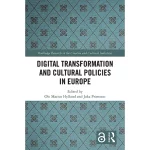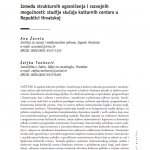
Izdavači: Naklada Jesenski i Turk i Hrvatsko sociološko društvo
Godina: 2008.
ISBN 978-953-222-284-5
Croatia’s declaration of independence in the early 1990s was followed by a war in which those active in the cultural sector used all the power at their disposal as part of the war effort to mobilise people in defence of the country and their heritage, and to strengthen national self-confidence. After this came a period of political self-isolation and with it a wave of cultural neo-conservatism and nationalism. At the beginning of 2000 a new climate developed of democratisation and opening up to the world. The official cultural-policy makers rejected neo-conservatism and nationalism and proclaimed new priority goals: culture as one of the development forces of society, democratisation and pluralism in culture, increased youth initiative, better management and creation of links between culture and the economy. Even so, many problems must still be faced: excessive and inefficient legislation, low level of extra-budget funding, uncoordinated ad ministration at different levels, the low general level of art education, the uncertain effects of privatisation, neglected technological infrastructure and culture industry, lack of funding for restoration and conservation, a lack of interest in culture a mong other sectors, etc.
This strategic document sets out the goals for cultural development in the Republic of Croatia in the twenty-first century:
- Overall goal – culturally sustainable development: developing knowledge and skills that increase interest in quality products of the elite, alternative and traditional or folk cultures and at the same time decrease antagonism and increase friendliness among people.
- In cultural policy: increasing the cultural capital (knowledge) for sustainable development.
- In art and cultural industries: developing culture as a goal in itself and as a means for the development of other sectors with the aim of raising the popular interest in quality products.
- In cultural heritage: ensuring that tradition continues to live in the new forms of modern life and sustainable development.
- In cultural relations: pluralism, openness, varied and innovative cultural cooperation.
- Cooperation with other sectors: working to make culture the developmental force of Croatia.
These goals will be ac hieved using the following instruments:
Cultural policy: inaugurating joint decision-making by experts in the Cultural Council; increasing extra-budgetary funding (donations, sponsoring, patronage); polycentric management-decentralisation of cultural planning to the level of the cultural and historical regions of Croatia; creating links between professionals, members of alternative cultural currents and amateurs to raise the cultural level of the population; finding more interesting forms of teaching and
promoting art than classical forms of education; employing new people on projects of sustainable development; introducing special packages of privatisation legislation and constantly monitoring their effects.
Art and the culture industries: increasing qual ity production by the culture industries; promoting the cultural public good in the same way as commercial goods are promoted; increasing private investment; treating culture more as production than as consumption; increasing exports.
Cultural heritage: offering new programmes and attracting foreign investors; commercialising heritage areas if necessary, but in a way that is compatible with cultural activities; computerising what Croatia has to offer; making heritage areas more a place of life and work than a place to visit and tour; further specialising the activities of galleries, museums, archives, libraries, monument areas.
Cultural relations: increasing communication and cooperation between the majority and minority cultures in Croatia in a wider contex t than language and the heritage; internationalising cultural events; increasing the variety of international cooperation; building the image of Croatia more to reflect inner reality than to achieve external appeal.
Cooperation with other sectors: bringing tourism and culture together; using new communication technologies in various fields of culture; founding an institute for cultural research and development; developing cultural management; transforming cultural capital (knowledge for the sake of knowledge) into socio – cultural capital (knowledge for sustainable development).
The effect of these instruments will be periodically examined and if necessary revised in accordance with their effect on the set goals of cultural development. With this in mind, the paper proposes a preliminary scale of 10 possible levels in the use of the instruments of cultural development in each of the above-mentioned fields. Finally it shows the main advantages and disadvantages of the strategic vision of cultural development.
This publication is available only in Croatian.
DOWNLOADS
This publication is available in elektronic format: Croatia in the 21st century: Strategy of cultural development (in Croatian)




